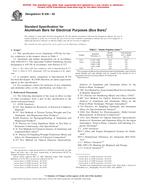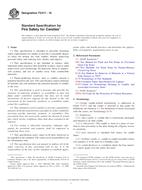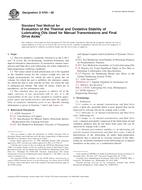1.1 This test method covers the determination of total sulfur in petroleum and petroleum products that are single-phase and either liquid at ambient conditions, liquefiable with moderate heat, or soluble in hydrocarbon solvents. These materials can include diesel fuel, jet fuel, kerosine, other distillate oil, naphtha, residual oil, lubricating base oil, hydraulic oil, crude oil, unleaded gasoline, gasohol, biodiesel (see Note 2), and similar petroleum products.
Note 1 – Oxygenated fuels with ethanol or methanol contents exceeding the limits given in Table 1 can be dealt with using this test method, but the precision and bias statements do not apply (see Appendix X3).
Note 2 – For samples with high oxygen contents (>3 wt %) sample dilution as described in 1.3 or matrix matching must be performed to assure accurate results.
1.2 Interlaboratory studies on precision revealed the scope to be 17 mg/kg to 4.6 mass %. An estimate of this test method's pooled limit of quantitation (PLOQ) is 17.0 mg/kg as calculated by the procedures in Practice D6259. However, because instrumentation covered by this test method can vary in sensitivity, the applicability of the test method at sulfur concentrations below approximately 20 mg/kg must be determined on an individual basis. An estimate of the limit of detection is three times the reproducibility standard deviation, and an estimate of the limit of quantitation is ten times the reproducibility standard deviation.
1.3 Samples containing more than 4.6 mass % sulfur can be diluted to bring the sulfur concentration of the diluted material within the scope of this test method. Samples that are diluted can have higher errors than indicated in Section 16 than non-diluted samples.
1.4 Volatile samples (such as high vapor pressure gasolines or light hydrocarbons) may not meet the stated precision because of selective loss of light materials during the analysis.
1.5 A fundamental assumption in this test method is that the standard and sample matrices are well matched, or that the matrix differences are accounted for (see 5.2). Matrix mismatch can be caused by C/H ratio differences between samples and standards (see Section 5) or by the presence of other heteroatoms.
1.6 The values stated in SI units are to be regarded as standard. No other units of measurement are included in this standard.
1.7 This standard does not purport to address all of the safety concerns, if any, associated with its use. It is the responsibility of the user of this standard to establish appropriate safety and health practices and determine the applicability of regulatory limitations prior to use.
TABLE 1 Concentrations of Interfering SpeciesA
| Element | Mass % Tolerated |
|---|---|
| Phosphorus | 0.3 |
| Zinc | 0.6 |
| Barium | 0.8 |
| Lead | 0.9 |
| Calcium | 1 |
| Chlorine | 3 |
| Ethanol (Note 11) | 8.6 |
| Methanol (Note 11) | 6 |
| Fatty Acid Methyl Ester (FAME) | 5 |
A The concentrations of substances in this table were determined by the calculation of the sum of the mass absorption coefficients times mass fraction of each element present. This calculation was made for dilutions of representative samples containing approximately 3 % of interfering substances and 0.5 % sulfur.
Product Details
- Published:
- 10/15/2008
- Number of Pages:
- 9
- File Size:
- 1 file , 130 KB
- Redline File Size:
- 2 files , 270 KB


